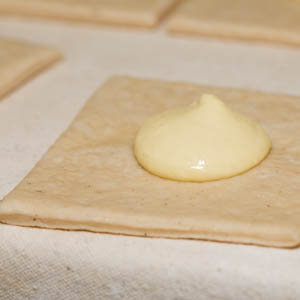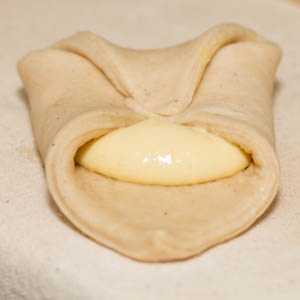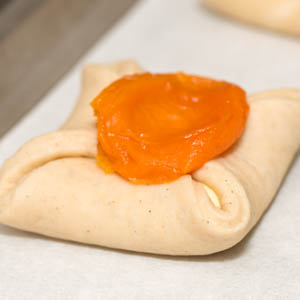Danish Apricot Envelopes

introduction
When you take a tart, singing stone fruit like an apricot, ensconce it on a mound of glossy almond and vanilla pastry cream, and wrap Danish dough all around it, really good things happen. The pastry is warm and buttery, the apricot slippery and tart, and the cream round and rich with little echo of almond paste. These snug bites deliver taste and textural synergy in high form. Our favorite Danish.
Baking Notes
A national brand of dried apricots we recently found in the supermarket had been processed with artificial apricot flavor or something. Avoid those! Apricots are tart, and that shivery tart side of their personality is huge part of their appeal. Dried apricots, more than other dried fruits, pull the qualities of their formerly fresh selves into exquisitely sharp focus. Because no single element of these Danish is outspokenly sweet, we liked plumping the apricots in a thin sugar syrup before using them.
equipment mise en place
To make the almond cream, you will need a digital kitchen scale; a 2-cup liquid measuring cup or a small bowl; a medium saucepan; a whisk; a mesh strainer; a small, deep bowl; and a heavy-bottomed medium saucepan,
To prepare the apricots, you will need a small saucepan.
To roll, shape, and bake the Danish, you will need a bench knife, a rimless cookie sheet, parchment paper, a couche or 3-foot-square heavy canvas cloth, a rolling pin, a ruler, four half sheet pans, an empty baking dish or pie plate, a pizza stone, a teakettle, a small bowl, a pastry bag fitted with a ½-inch plain pastry tip, a metal bench knife or pizza cutter, a pastry brush, a small offset spatula, an electric knife or sharp bread knife, two wire racks, and a wide metal spatula.
For the glaze you will need a small saucepan, a whisk, a small strainer, a small bowl, and a pastry brush.
-
for the almond cream:
-
2.7ounces egg yolk, beaten (from 4 large eggs)
-
12ounces half-and-half
-
2ounces almond paste, sliced or pinched into small bits
-
0.6ounces Anson Mills Fine Cloth-Bolted Pastry Flour, sifted
-
1ounce granulated sugar
-
Pinch of fine sea salt
-
1teaspoon vanilla extract
-
0.5ounce unsalted European-style butter
-
-
for the apricots:
-
18small dried apricots
-
3.5ounces granulated sugar
-
12ounces spring or filtered water
-
-
-
1
-
Anson Mills French Mediterranean White Bread Flour or Colonial Style Fine Cloth-Bolted Pastry Flour, for dusting
-
1large egg
-
-
for the glaze:
-
7ounces apricot jam or preserves
-
1ounce water
-
-
The day before you plan to bake, make the almond cream: In a 2-cup liquid measuring cup or small bowl, whisk together the egg yolks and 1 ounce (2 tablespoons) of the half-and-half. Add the flour and whisk vigorously until the mixture is smooth and free of lumps. Set a mesh strainer over a small, deep bowl.
-
In a heavy-bottomed medium saucepan, bring the remaining half-and-half, the almond paste, and the salt to a simmer over medium heat until simmering, whisking vigorously to dissolve the almond paste. As soon as the mixture reaches a simmer, pull the saucepan off the burner. While whisking the yolk mixture, ladle in about ½ cup of the hot half-and-half mixture and continue to whisk until fully incorporated. Repeat with the remaining half-and-half. Pour the mixture into the saucepan and cook over medium heat, whisking continuously, until the mixture thickens and bubbles burst on the surface, 20 or 30 seconds, then allow the cream to bubble for 10 seconds more. Remove the pan from the heat and whisk in the vanilla and butter. The cream should be pudding-like and glossy. Transfer it to a small bowl (fig. 2.1), press plastic wrap directly against surface, and refrigerate overnight.
-
The day of baking, plump the apricots: Combine the water and sugar in a small saucepan. Bring to a simmer over medium-high heat. Swirl the pan to help the sugar dissolve. When the sugar has dissolved and the syrup is clear—just a few minutes—remove from the heat. Let cool until the temperature of a hot bath. Turn the apricots into a small bowl, add the syrup to cover them, and set them aside until ready to use.
-
Roll out the dough: Remove the dough from the refrigerator and cut it in half crosswise with a bench knife; each half should weight 18-plus ounces. Rewrap each half, return one piece to the refrigerator, and allow the other piece to rest at room temperature for 15 minutes.
-
Line a rimless cookie sheet with parchment paper. Lay a couche or 3-foot-square heavy canvas cloth on the counter. Dust the couche with flour, unwrap the dough, set it on the couche, and lightly flour the dough. Roll it into a 10-inch square. Slide the dough onto the prepared cookie sheet, cover it lightly with plastic wrap, and refrigerate it for 30 minutes to allow it to relax.
-
While the dough is resting, line 2 half sheet pans with parchment paper and set them, along with 2 additional half sheet pans, aside. Adjust the oven racks to the lowest and upper-middle positions. Set an empty baking dish or pie plate on the lower rack and a pizza stone on the upper-middle rack. Fill a teakettle with water and set it on the stove, but don’t turn on the heat. Drain the apricots and dry them on paper towels. In a small bowl, beat the egg and set it aside. Fit a pastry bag with a ½-inch plain tip and transfer the chilled almond cream to the bag.
-
Fill and form the Danish: Lightly flour the couche. Unwrap the dough, set it on top, and lightly flour the dough. Roll out the dough to a 12-inch square. Using a ruler and a bench knife or pizza cutter, trim the edges to make a tidy square.
-
Remove the apricots from the sugar syrup and drain them on several thicknesses of paper towel. Using a ruler and a bench knife, notch the edges of the dough to mark nine 4-inch squares (3 down and 3 across) (fig. 8.1), then use a pizza cutter and the ruler to cut the squares (fig. 8.2). Brush the edges of the squares very lightly with the beaten egg. Pipe about 1½ tablespoons of almond cream into the center of each square (fig. 8.3). Working with one square at a time, fold two opposite corners to meet in the center, overlapping the points slightly, then fold in the remaining two opposite corners in the same way (fig. 8.4). Press firmly on the center with your thumb to seal the points, then press an apricot, cut side down, into the center (fig. 8.5).
-
Arrange the envelopes on one of the parchment-lined sheet pans, spacing them evenly apart. Invert one of the unlined half sheet pans over the filled pan, forming a proofing box, and let the envelopes rise until they are nearly doubled in size, about 2 hours. About 30 minutes into the rising, repeat the process with the remaining half of the dough, almond cream, and apricots.
-
After the first batch of envelopes have proofed for about 1 hour, heat the oven to 400 degrees. After about 1¾ hours of proofing, bring the kettle of water to a boil. About 5 minutes before baking, pour 1 inch of the boiling water into the empty dish on the lower oven rack.
-
Bake the Danish: Slide the first batch of Danish into the oven and immediately lower the temperature to 375 degrees. Bake until golden brown and well-risen, about 20 minutes (fig. 11.1), turning the sheet pan front to back halfway through.
-
Set the sheet pan on a wire rack and let cool 5 minutes. Increase the oven temperature to 400 degrees and return the kettle of water to a boil. Using a wide metal spatula, transfer the Danish directly to the wire rack, then set the rack in the now-empty sheet pan.
-
While the Danish are still hot, make and apply the glaze: In a small saucepan, bring the apricot preserves and water to a simmer over medium heat, whisking to break up the pieces of apricot. Simmer until the preserves are thick enough to coat the back of a metal spoon. Strain through a mesh strainer set over a small bowl. Brush the hot glaze over the still-warm baked Danish (fig. 13.1). Let cool for 5 to 10 minutes, then serve warm or allow to cool completely and serve, but for optimal enjoyment, consume the Danish within a few hours of baking.
-
Bake the second batch of envelopes as you did the first batch, pouring additional water in the dish on the lower oven rack about 5 minutes before baking.
-
-
2.1

-
-
-
8.1

-
8.2

-
8.3

-
8.4

-
8.5

-
-
-
11.1

-
-
-
13.1

-